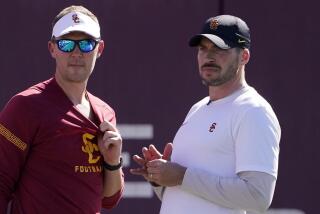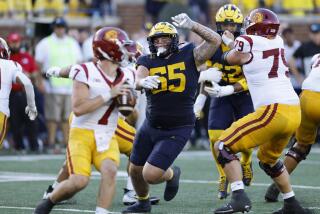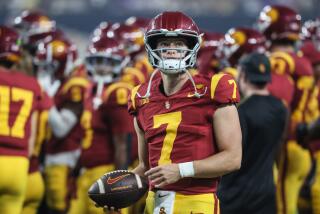Trophy Line
DAVIE, Fla. — Zach Wilson strolled past Heisman trophies in the lobby of USC’s Heritage Hall almost every day for the last five years.
The senior offensive lineman recognized the significance of the statuettes won by tailbacks Mike Garrett, O.J. Simpson, Charles White and Marcus Allen, but never really gave them a second look.
Two weeks ago, Wilson spent time meticulously examining every detail of quarterback Carson Palmer’s Heisman Trophy upon the quarterback’s return from New York.
“A piece of that thing -- maybe just a body part, a foot -- is mine,” Wilson said. “Every O-lineman on the team can say the same thing. We all had a part in it.”
USC’s offensive line, maligned a year ago, matured this season into one of the best in the Pacific 10 Conference and helped the fifth-ranked Trojans (10-2) earn a berth in Thursday’s Orange Bowl game against third-ranked Iowa (11-1).
USC’s linemen average 6 feet 5 tall and 298 pounds. Iowa’s offensive line averages 6-6, 296 pounds and is regarded as possibly the best in the nation.
The Trojans intend to show that they deserve similar praise.
“I think there are still some doubts about the line out there,” junior Eric Torres said. “What better venue to show people than the Orange Bowl?”
Before the season began, Trojan linemen blamed no one but themselves for their suspect status.
In 2001, virtually the same group of players allowed Palmer to be sacked 36 times. USC, with an injury-depleted tailback corps, rushed for a conference-worst 87.7 yards a game, and the Trojans finished a 6-6 season by rushing for one yard in a 10-6 loss to Utah in the Las Vegas Bowl.
“We didn’t need much more than those numbers to motivate us,” junior center Norm Katnik said.
This season, the Trojans allowed only 22 sacks, fewest in the conference. They also increased their rushing average to 133.8 yards a game, fourth-best in the Pac-10.
The combination helped Palmer pass for 3,639 yards and 32 touchdowns.
“We were hoping we could be the best in sacks [allowed] and get into the average range in the running game -- we thought that would be enough to make our passing game really light it up,” Coach Pete Carroll said. “And that’s what happened. The pass protection was pretty much right on the money.”
Offensive line coach Tim Davis was a catalyst for the improved performance. Davis, who was hired last March after five seasons at Wisconsin, injected a healthy dose of intensity to complement the more reserved Keith Uperesa, who works with tackles and tight ends.
Carroll and offensive coordinator Norm Chow also modified the way Palmer operated, eliminating many of the deep drops in favor of quicker throws from either the pocket or on the roll-out.
Finally, the tailback corps remained deep throughout the season. Malaefou MacKenzie and Sultan McCullough shared the bulk of the carries before Justin Fargas finally shook a hamstring problem and started the final five games.
“We wouldn’t be where we are if the line didn’t come through the way it did,” Palmer said. “They definitely set the tone for the offense this year.”
USC overcame a perceived lack of depth by quickly developing freshman Winston Justice into a starter at right tackle. The 6-6, 305-pound freshman from Long Beach Poly did not play in the opener against Auburn, but progressed during a bye week and was thrust into the lineup against Colorado.
Justice passed his biggest test when he neutralized national sack leader Terrell Suggs of Arizona State in the 10th game.
“I still think I have a lot to learn, but I expected to be good because Coach Carroll put that in my mind when he recruited me,” said Justice, who was named a freshman All-American.
While Justice and junior Jacob Rogers provided stability at tackle, Torres and senior Derek Graf proved valuable in utility roles.
Torres started at every position on the line except center. He played the final three games at left guard after Lenny Vandermade suffered a torn biceps. Graf started in place of Wilson at right guard against Auburn. He started at center, then alternated with Katnik, in the regular-season finale against Notre Dame.
“At the start of the year, I had each guy write down their goals,” Davis said. “Every one of them wrote the same thing, ‘to be the best O-line in the Pac-10.’ That’s how you get there. That’s what they did.”
Next season, Wilson and Graf will be gone, but redshirts Fred Matua and Kyle Williams are among the players expected to play significant roles. The onus on the line will be even greater because a new quarterback and running backs will be operating behind it.
“We’ll have starters on the line coming back,” Katnik said. “We’ll hit the ground running.”
Justice said he would begin thinking about next season after the Orange Bowl. This year’s line, he believes, quietly stirred memories of Trojan units of the past.
“I think we’re starting anew, starting our own dynasty,” Justice said. “In 20 years, they’re going to look back at 2002 and say, ‘That was a good offensive line. That was the group that started it.’ ”
More to Read
Go beyond the scoreboard
Get the latest on L.A.'s teams in the daily Sports Report newsletter.
You may occasionally receive promotional content from the Los Angeles Times.







